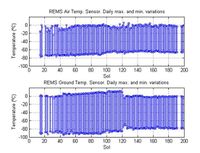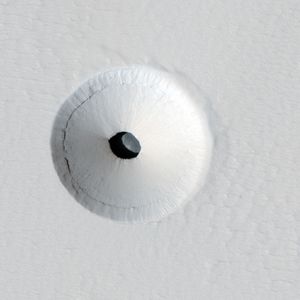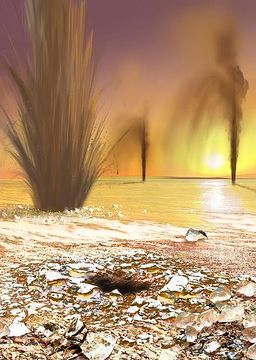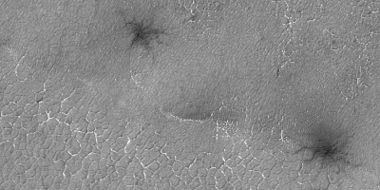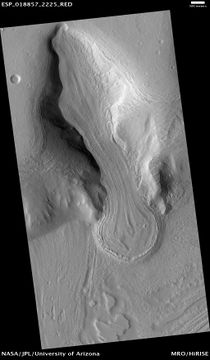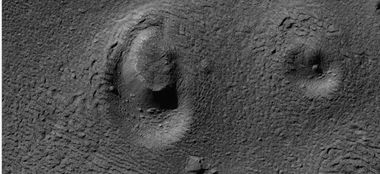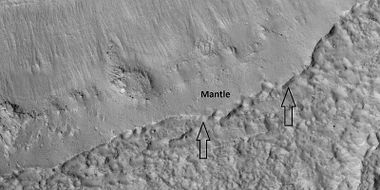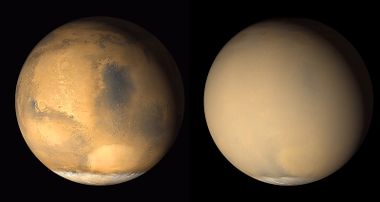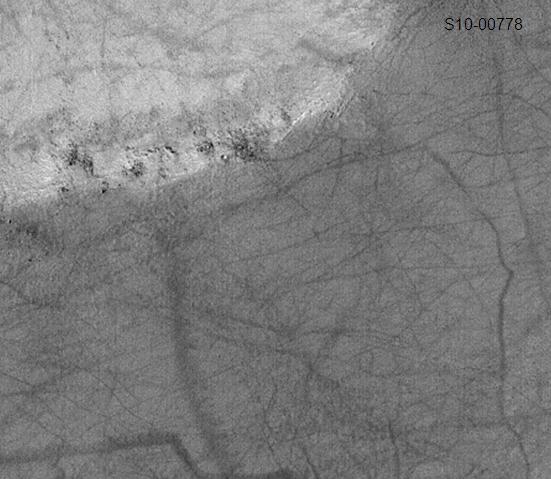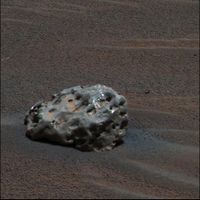How living on Mars will be different than living on Earth
Article written by Jim Secosky. Jim is a retired science teacher who has used the Hubble Space Telescope, the Mars Global Surveyor, and HiRISE.
This article describes major differences between Mars and the Earth, especially ones that may impact colonies. At some time in the future, Mars will be terraformed . It will have a much thicker atmosphere and more moderate temperatures. Perhaps in a hundred years or so there will be hundreds of people living in at least several underground colonies.
For a look at the various landscapes on Mars that colonists will explore see "What Mars Actually Looks Like!."
Contents
Weather and Atmosphere
A major concern will be dealing with the weather and atmosphere. The atmosphere is very thin, less than 1% of the Earth’s. Because of its much greater distance from the sun, Mars is very cold, and its usual clear air makes the temperature fall greatly at night. The average temperature on Mars is 81 degrees below 0 F, as compared to 57 degrees F on Earth. The average range for Mars temperatures is −125 and 23 °F ( −87 and −5 °C ). [1] [2]
The extremely harsh temperatures may not be much of a problem because the colonies may be well insulated in underground colonies and with the use of advanced insulation materials
Many science fiction movies/programs have emphasized the strong winds on Mars.[3] However, because the air is so thin, the wind has little effect on the ground and may be of little concern to colonists. However, there is some speculation that near the ice caps on a few days there may be high wind speeds when the dry ice from the caps changes to a gas phase, but the first colonies are unlikely to be near the poles to be affected by these possible strong winds. Near the southern pole during certain periods features, called “spiders” form when weak areas in the ice break , making vents that are 15 to 50 meters (yards) wide. This process releases gas from the vents at speeds of 90 mi/hour (150 km/hour) or more.[4]
Close view of spider formations, as seen by HiRISE During the winter season, a slab of dry ice forms on the ground surface. The surface contains cracks in the shape of polygons. During certain times, CO2 under the ice becomes pressurized from sunlight penetrating the slab of dry ice. As the gas moves around the channels become larger.
The atmosphere of Mars has just a trace of oxygen and a much smaller amount of nitrogen than the Earth (less than 2%). We will need to obtain oxygen, probably by passing electricity through water to break it down into hydrogen and oxygen in a process called “electrolysis.” The hydrogen can be used for rocket fuel directly or converted to methane that can be more easily stored. This process requires a fair amount of energy, so solar power may have to be supplemented with other means of power production, such as nuclear. On the other hand, much of the oxygen that is used may be recycled by plants in greenhouses. Water for the colonies can be obtained by mining ice in various formations on the planet.
Robotic machines may carry this out. Greenhouses may be underground with artificial lighting provided by LED’s. We would want to protect plants from radiation by growing plants underground.[5] [6] Living in pure oxygen may be too dangerous because of the risk of fire. Nitrogen could be concentrated from the atmosphere to mix with the colony’s artificial atmosphere.
World without pests
Colonies on Mars would be a golden opportunity to create a more perfect world if we can prevent the transport of insect pests from the Earth. Imagine a world without the mosquito or many of the insects that feast on our vegetables! It could be a boom to food production if we would not have loses from mice, rats, bean beetles, cabbage worms, and other pests. It would also be really nice to also keep all of our mildews, molds, and smuts on the Earth, but that may prove impossible. Keeping colonies isolated from each other may at least decrease the spread of pests.
Dust and Dust Storms
At present Mars has a tilt similar to the Earth’s, consequently it experiences four seasons. However, the seasons are not equal. They are also much longer because it takes Mars almost 2 years to orbit the sun. The planets orbit the sun, not in circles, but as ellipses. Most planets have orbits that are close to circles, like the Earth. Traveling in an ellipse means that the planet is sometimes closer to the sun than at other times. The Earth is close to the sun when it is winter in the northern hemisphere. Since the difference in distance from the sun in the winter and summer is slight (3%), this difference does not affect our climate. In contrast, there is a big difference in the distance to the sun for Mars during the winter and summer seasons (about 17%).[7] Also, the length of the summer and winter seasons is different. A planet moves faster when it is closer to the sun; hence the when Mars is closest to the sun in the southern summer, it moves faster in its orbit.[8] [9] Martian summer in the southern hemisphere is both warmer and shorter than summer in the northern hemisphere. When Mars is closest to the Sun, solar energy is 45% stronger than when Mars is farthest from the Sun.[10] Global dust storms often begin in the southern hemisphere as the summer season approaches.[11] One planet-wide Dust Storm began in May of 2018 and did not begin to clear until July 2018.[12] [13] [14]
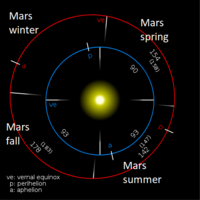
It is important to understand global dust storms and be able to predict them, as they can greatly reduce sunlight for solar panels. We may not want to totally depend on solar power for Martian colonies because dust storms may last months. In addition, because of the high levels of atmospheric dust, there should be some way to clean solar panels. Dust may cause further problems if it works its way into machinery.[15] The dust particles in the atmosphere of Mars are very small, about like the particles in talcum powder or cigarette smoke with the average being 3 micrometers in diameter.[16] [17] With the Mars Pathfinder we determined the particles in the atmosphere to have a radius of 1 micron (also called a micrometer) which is equal to 1 millionth of a meter.[18] [19]
Radiation
Another major concern for living on Mars will be minimizing exposure to Radiation. While traveling to Mars, the Mars Science Laboratory detected relatively high levels of energetic particle radiation.[20] [21] [22] Although Mars possessed a magnetic field in the distant past, today there is no major magnetic field that could protect colonists from lower energy Cosmic Rays. Living underground would give some protection from these particles. (See also using lava tubes for locations of habitats.)
There has also been some work done with building some sort of force field to divert charged particle radiation.[23] [24]Such a field may be produced with a thin screen that has electricity running through it.[25] [26] Other radiation from the sun will also need to be dealt with because of the thin atmosphere. The sun at times emits large amounts of solar energetic particles (SEPs).[27] [28] [29] Some cosmic rays come from the sun, but many come from outside the solar system.[30]
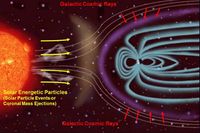
These can be very dangerous because they move a great speeds and some are composed of the nuclei of heavier elements.[31] In college chemistry class, we had to calculate the energy of a typical heavy particle of cosmic rays—it came out to be about the same as being hit by a baseball. (Discussion Needed.) If a solar flare were found to be heading towards Mars, colonists would have to stay in their underground quarters. Such flares would be discovered several days in advance of their arrival by satellites and telescopes. With the combined dangers from cold temperatures and radiation, colonists would not be roaming around outside very much. Much exploration will need to be done with small rovers/drones/balloons, and with powerful telescopes in orbit. Drones may not be an easy answer due to the extremely thin Martian atmosphere. By the time Mars is being colonized, there will be telescopes/spectroscopes in orbit with very high resolution. Today, HiRISE can see objects less than a meter across. In a hundred years, we may be about to see things just a few centimeters across. Still, on Mars we will need to gather samples or examine materials after dusting off a coating of dust. Dust covers up the true nature of most surfaces on the planet. While not being able to walk around, it may seem like a big hardship, it is similar to what occurs to crews in Antarctica or in submarines.
Strange Facts
Pattern of large and small tracks made by giant dust devils, as seen by Mars Global Surveyor under the MOC Public Targeting Program
There are a few aspects of Mars that are unusual. There are only two tiny moons, instead of one big one. These moons orbit Mars in just a day or so. Deimos, the more distant of the two, would only appear 1/19 the size of Earth’s moon, while Phobos would seem to be 1/3 the diameter of Earth’s moon. Phobos would go through all its phases in a day.[32] The stars and constellations will be the same as seen from the Earth, but there will be no North star because the present tilt of Mars is slightly different than the Earth. Since the planet is only a fraction of the diameter of Earth, the horizon will be much closer. Although Mars has many beautiful landscapes, we may not be able to appreciate them too much as their distant parts will be below the horizon.
The surface of Mars experiences many huge dust devils that have cleaned the solar panels of landers, thereby greatly extending their lives. They leave beautiful curved lines on the surface. The pattern of the tracks of lines has been shown to change every few months.[33] A study that combined data from the High Resolution Stereo Camera (HRSC) and the Mars Orbiter Camera (MOC) found that some large dust devils on Mars can have a diameter of 700 m and last at least 26 minutes.[34] Some have been measured to be 12 miles high.[35]
Of course the small size/mass of Mars would result in much less weight for everything. Objects would fall much slower. Future exercises and sports on Mars will be spectacular. With only 38% of the gravity of Earth, we could jump up much farther and throw things farther.[36] Some athletes in fitness centers jump onto platforms 4 feet high. On Mars they could jump over 12 feet.[37] People may be able to jump up an entire flight of stairs. The record for the shotput may be over twice that of the Earth.
Future Mud
Large areas of the surface are covered by what has been called a latitude dependent mantle. It is a mixture of ice and dust that fell from the sky and accumulated . When the planet’s terraforming advances to the point where parts of the planet are above the freezing point of water, this mantle material may turn into mud.
Finding Meteorites
Our rovers have spotted a number of meteorites on the Martian surface.[38] [39] [40] [41] [42] [43] These meteorites may be a valuable resource for the colony. Depending on the type found, they may be a good source of metals or possibly of rare Earth elements which are used in many electronic devices. Much effort may go into finding and using these meteorites.
Studying Life
In 100 years we may have discovered existing life or traces of ancient life. Either way, the colony will have many biologists and biochemists looking for life or characterizing the life. Just discovering the nature of the chemicals of the planets life would be exciting. Would their DNA, RNA, proteins, fats, and enzymes be similar to ours?
References
- ↑ http://solarviews.com/eng/mars.htm
- ↑ https://hypertextbook.com/facts/2001/AlbertEydelman.shtml
- ↑ https://www.nasa.gov/feature/goddard/the-fact-and-fiction-of-martian-dust-storms
- ↑ https://marsed.asu.edu/mep/ice/polar-caps/planum-australe
- ↑ https://www.sciencedirect.com/science/article/pii/S0019103521003171
- ↑ Moreiras, D. 2021. The ultraviolet radiation environment and shielding in pit craters and cave skylights on Mars. Icarus. Volume 370.
- ↑ https://mars.nasa.gov/allaboutmars/facts/#?c=inspace&s=distance
- ↑ http://www.science20.com/robert_inventor/seasons_on_mars_how_do_they_compare_with_earth-167228
- ↑ https://mars.nasa.gov/allaboutmars/extreme/martianyear/
- ↑ https://marsed.asu.edu/mep/dust
- ↑ https://www.jpl.nasa.gov/news/news.php?feature=6638
- ↑ https://www.space.com/41302-mars-dust-storm-dying-down.html
- ↑ https://mars.nasa.gov/weather/storm-watch-2018/
- ↑ https://mars.nasa.gov/resources/21920/2018-giant-dust-storm-on-mars/
- ↑ https://www.nasa.gov/feature/goddard/the-fact-and-fiction-of-martian-dust-storms
- ↑ https://www.engineeringtoolbox.com/particle-sizes-d_934.html
- ↑ https://marsed.asu.edu/mep/dust
- ↑ Smith, P. et al. 1997. Results from the Mars Pathfinder Camera. Science: 278. 1758–1765
- ↑ https://en.wikipedia.org/wiki/Micrometre
- ↑ Kerr, Richard (31 May 2013). Radiation Will Make Astronauts' Trip to Mars Even Riskier. Science. 340 (6136): 1031. doi:10.1126/science.340.6136.1031
- ↑ Zeitlin, C. et al. (31 May 2013). Measurements of Energetic Particle Radiation in Transit to Mars on the Mars Science Laboratory. Science. 340 (6136): 1080–1084.
- ↑ Chang, Kenneth (30 May 2013). Data Point to Radiation Risk for Travelers to Mars. New York Times.
- ↑ https://news.nationalgeographic.com/news/2008/11/081104-magnetic-shield.html
- ↑ G.Landis 1991. Magnetic Radiation Shielding: An Idea Whose Time Has Returned? https://www.researchgate.net/publication/253983200_Magnetic_radiation_shielding_An_idea_whose_time_has_returnedquest
- ↑ https://www.sciencealert.com/scientists-are-developing-a-magnetic-shield-to-protect-astronauts-from-cosmic-radiation
- ↑ Parker, E. 2005. Shielding Space Explorers From Cosmic Rays. Space Weather. 3, Issue 8
- ↑ https://helios.gsfc.nasa.gov/sep.html
- ↑ http://www.skyandtelescope.com/astronomy-news/radiation-dangers-for-mars-astronauts-downgraded/
- ↑ https://helios.gsfc.nasa.gov/flare.html
- ↑ https://helios.gsfc.nasa.gov/cosmic.html
- ↑ http://www.pbs.org/wgbh/nova/space/cosmic-rays.html
- ↑ https://www.space.com/28403-astronauts-mars-skywatching-phobos-deimos.html
- ↑ http://hirise.lpl.arizona.edu/PSP_005383_1255
- ↑ Reiss, D. et al. 2011. Multitemporal observations of identical active dust devils on Mars with High Resolution Stereo Camera (HRSC) and Mars Orbiter Camera (MOC). Icarus. 215:358-369.
- ↑ https://www.jpl.nasa.gov/news/news.php?release=2012-095
- ↑ https://mars.nasa.gov/allaboutmars/facts/#?c=theplanet&s=gravity
- ↑ https://mars.nasa.gov/ask-nasa-mars/#/
- ↑ Schröder C. et al. 2008. JGR, 113, E06S22, 10.1029/2007JE002990
- ↑ Ashley J. W. 2009. LPS XL, Abstract #2468
- ↑ Ashley J. W. 2011. JGR, 116, E00F20, 10.1029/2010JE003672
- ↑ Arvidson R. E. et al. 2011. JGR, 116, E00F15, 10.1029/2010JE003746.
- ↑ Meslin P.-Y. et al. 2017. LPS XLVII, Abstract #2258
- ↑ Ashley J. W. and Herkenhoff K. E. 2017. LPS XLVII, Abstract #2656
See also
- Dust devils
- Glaciers on Mars
- High Resolution Imaging Science Experiment (HiRISE)
- Terraforming Mars
- Martian features that are signs of water ice
- In-situ resource utilization
- Air
- Water
External links
- Martian Ice - Jim Secosky - 16th Annual International Mars Society Convention
- https://www.youtube.com/watch?v=kpnTh3qlObk[T. Gordon Wasilewski - Water on Mars - 20th Annual International Mars Society Convention] Describes how to get water from ice in the ground
